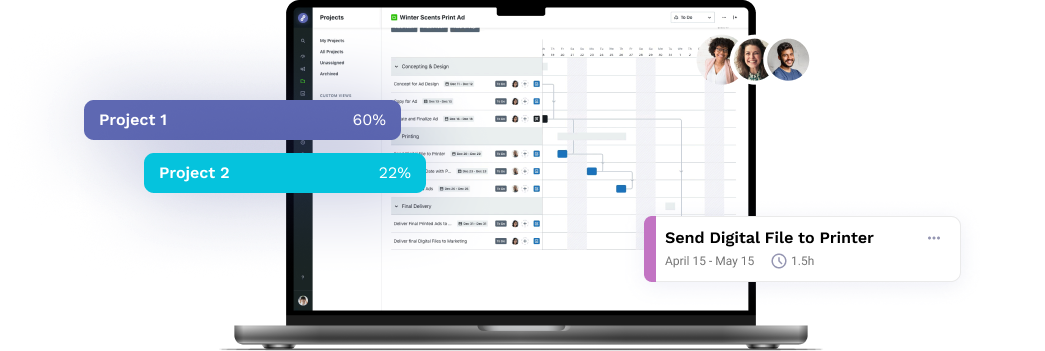
Creative Methods to Tackle Thorny Creative Challenges
Your creative team begins a brainstorming session with the goal of agreeing on the creative direction of a new campaign. Instead of keeping an open mind and listening to each other, your team members come with their own ideas each. The session quickly turns into a battle of wits, wordplay, and egos. What you intended as a collaborative team exercise has turned into creative chaos central. You have plenty of raw ideas at your disposal with no real plan of action. So, what is a creative leader like yourself supposed to do?
In practice, analysis paralysis happens the most often when:
- People focus on solutions before everyone is sure what the actual goal is.
- You do not have enough information up front to be able to define a full solution.
- The problem you are addressing is a mere symptom, not the root cause.
There are dozens of different methodologies to help you define projects. Here are the three we have found to be most helpful:
Method 1: Think Like a Journalist
Ever heard of the 5W+H formula? It’s an acronym for who, what, when, where, why, and how. This storytelling guideline works wonders for you and your project stakeholders. Let us expand on it:
Who is your audience? Think about and define the persona of the ones facing a theoretical problem. Next, name your stakeholders that you need input from for your upcoming solution. Then, decide on who needs to approve everything. Finally, select who you want to keep in the loop during the entire process.
What is your audience trying to do? Focus on defining the problem or challenge that your personas are faced with.
When – and how often – does your audience face this problem? Is it an intermittent minor annoyance or a major, business-critical issue?
Where is your audience when they face this problem? For starters, this question is designed to help you define the scope you need to work under. Then, it can also lend itself to helping you figure out the most suitable platform for your solution.
Why should your audience choose you over the competition? Consider what sort of differentiators can you uniquely offer to them that they cannot get anywhere else. Is it your impeccable customer support? Perhaps your UX journey is unmatched? Could it be that one of your features is unique to your solution? Pinpointing and communicating your Unique Selling Points (USPs) will give you a competitive edge.
What Are Your Success Metrics for the Project?
Finally, once everyone is aligned on the above, you can brainstorm for potential solutions. This method works well when you aren’t sure where to start. You can use this method to lead whiteboard discussions, or as a personal checklist to make sure all bases are covered. You can also use it as the basis of a simple creative brief template that stakeholders fill out on their own with ease. The effectiveness of this creative method lies in its huge popularity and massive appeal.
It’s a good method to use in groups where people jump directly to the fun part, unaware of the constraints that your team may have. Once your 5W+Hs are defined, get stakeholders together and instruct them to present possible creative solutions.
Method 2: Empathize and Experiment
If you’re designing a big, complex, expensive system or product, you need to make sure up front you’re solving the right problem for the right audience, and put time and effort into making sure you’ve identified all of your requirements, documented your processes, codified your solutions, etc.
But what if you’re doing something so completely new (or new to you) that you don’t even have enough data to figure out what you don’t know?
Enter the Design Thinking process. When your primary goal is innovation, sometimes it can be more productive in the long run to get out something (if you’re developing new software, for example, it’s called a Minimum Viable Product or MVP), see how it does, and then fix problems as they arise or add features as they are needed.
This methodology closely follows actual users to determine what the next best improvement will be – or, basically, to learn by doing.
How to Make Your Creative Methods Successful
Empathize. There are a number of research methodologies to do this, but in general, watch your user to understand their pain points.
Define. Identify which pain point will have the most user impact or makes the most sense next in your product cycle.
Ideate. Bring your team together to brainstorm possible solutions, ways to solve the problem, or hypotheses to test.
Prototype. Often this involves building a rough schematic or wireframe with just enough detail to test your idea.
Test. Again, there are multiple ways of doing this, but it’s important to test with real users, even just a few of them.
Iterate. Keep creating quick prototypes and testing with users. You can uncover more issues running several rounds of tests with fewer users (even just three rounds with 3-5 users per round) than running one large scale test where everyone gets stuck on the same problem.
Implement. Be sure to set up creative methods that allow for measuring your outcomes, so you can be sure that you’re actually improving the experience.
A simpler way of remembering creative methods like this one is to boil it down to three steps: Think, Make, and Check. Think about what your user needs, make a solution to test, then check your solution with actual users. This method obviously works best in situations where making updates is relatively easy and inexpensive – generally digital solutions. You probably wouldn’t be able to run enough iterations to get to any reasonable improvements in a publication that only prints once a year, for example.
Method 3: Channel Your Inner Three-Year-Old
Decades ago, Toyota Motor Corporation codified this curiosity and developed the “Five Why’s” system as the basis of their problem-solving process. The idea is to keep asking why until you get to the root cause that you can actually fix or a broken process you can actually address. In other words, the key is not to stop at the classic reasons of not enough time, budget, or resources. This method also keeps everyone focused on fixing problems and ensuring it doesn’t happen again, not just assigning blame (and then having it happen again to someone else).
The Five Why’s is a great strategy for when you already have a “thing” out there, but have recurring problems, and you aren’t exactly sure how to fix the actual root cause. This method works best when you can engage with the people who identify the problems most often, as well as those who understand the technical aspects enough to actually answer the Why? Questions. In other words, if you don’t know the answer to a question, go find someone who does, or pause to go find out the answer – guessing won’t help you here.
Asking Why? 5 times is a general guideline; it may take you more or less to practice. The method has been around long enough that there are numerous applications and methods for how to deploy it. You may need a bit of practice to ensure you’re asking the right Why? Questions, but keep it in mind for times when your other methods of problem solving are getting answers like “human error” or “not enough resources” – in other words, things you can’t actually fix.
Final Thoughts on Creative Methods
Whether you need to get unstuck at the beginning of a project, while trying to figure out your next step, or while fixing a problem with your existing product, one of these creative methods will help you and your team work through the mess. All of them cut to the heart of making sure you’ve clearly defined the right problem – because a beautiful solution to the wrong problem is still, unfortunately, the wrong solution.
Are you looking to troubleshoot the creative problems you and your team are facing? Lytho helps you streamline your entire workflow and harmonize all brand collateral under a single, uniform platform. Feel free to reach out to us by scheduling a demo and learning how our creative solutions can boost the effectiveness of your creative projects. We look forward to speaking with you!
Do you want to give yourself and your creative team more room for creative stimulation by automating the boring stuff? Lytho helps you streamline your entire workflow and harmonize all brand collateral under a single, uniform platform. Feel free to reach out to us by scheduling a demo and learning how our creative solutions can boost the effectiveness of your creative projects. We look forward to speaking with you!

Ready to simplify your creative operations and start having a little fun at work again? Schedule time to talk with us.
Let us show you how Lytho’s Creative Operations Platform helps in-house creative and marketing teams do better work, ease the stakeholder experience, and stay on brand.
Schedule a Demo